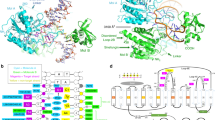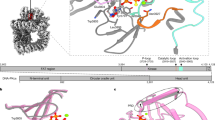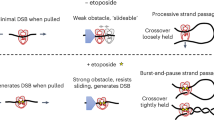Abstract
ACTINOMYCIN D (Fig. 1a) binds to DNA by intercalation of the phenoxazone ring between adjacent base pairs of the double helix1–4. There is a general requirement for a guanine base at the actinomycin D binding site on DNA, as illustrated by the observation that actinomycin D does not intercalate into double-stranded (ds) poly(dA-dT)·poly(dA-dT) (refs 1–4). Daunorubicin, adriamycin (Fig. 1b) and ethidium bromide (Fig. 1c) also intercalate into dsDNA, but in contrast to actinomycin D, these drugs do not show any requirement for a particular base at the intercalation site5,6. Both actinomycin D and ethidium bromide do, however, show definite preferences for binding to certain sequences of nucleic acid bases at the intercalation site7–11. In this report we show that daunorubicin and adriamycin facilitate strong binding of actinomycin D to poly(dA-dT)·poly(dA-dT) and we discuss the implications of this new observation.
This is a preview of subscription content, access via your institution
Access options
Subscribe to this journal
Receive 51 print issues and online access
$199.00 per year
only $3.90 per issue
Buy this article
- Purchase on Springer Link
- Instant access to full article PDF
Prices may be subject to local taxes which are calculated during checkout
Similar content being viewed by others
References
Meienhofer, J., Atherton, E. Adv. appl. Microbiol. 13, 203–300 (1976).
Sobell, H. M. Prog. Nucl. Acids Res. 13, 140–153 (1973).
Goldberg, I. H. & Friedman, P. A. A. Rev. Biochem. 40, 775–810 (1971).
Wells, R. D. in Progress in Molecular and Subcellular Biology, 2 (ed. Hahn, F. E.) 21–32 (Springer-Verlag, New York, 1971).
LePecq, J.-B. Meth. Biochem. Anal. 20, 41 (1971).
Henry, D. W. in Cancer Chemotherapy (ed. Sartorelli, A. C.) Am. Chem. Soc. Symp. Ser. 30, 15–57 (1976).
Krugh, T. R. Proc. natn. Acad. Sci. U.S.A. 69, 1911–1915 (1972).
Krugh, T. R. & Neely, J. W. Biochemistry 12, 4418–4425 (1973).
Krugh, T. R. & Reinhardt, C. G. J. molec. Biol. 97, 133–162 (1975).
Reinhardt, C. G. thesis, Univ. Rochester (1977).
Chen Chiao, Y-C. & Krugh, T. R. Biochemistry 16, 747–755 (1977).
Hollstein, U. Chem. Rev. 74, 625–652 (1974).
Krugh, T. R., Wittlin, F. N. & Cramer, S. P. Biopolymers 14, 197–210 (1975).
Crothers, D. M., Sabol, S. L., Ratner, D. I. & Muller, W. Biochemistry 7, 1817–1823 (1968).
Yamaoka, K. & Ziffer, H. Biochemistry 7, 1001–1008 (1968).
Homer, R. B. Archs Biochem. Biophys. 129, 405–407.
Quadrifoglio, F. & Crescenzi, V. Biophys. Chem. 2, 64–69 (1974).
Arcamone, F. et al. in International Symposium on Adriamycin (eds. Cart, S. K. et al.) 9–22 (Springer-Verlag, New York, 1972).
Auer, H. E., Pawlowski-Konopnicki, B. E. & Krugh, T. R. FEBS Lett. 73, 167–170 (1976).
Burd, J. F., Wartell, R. M., Dodgson, J. B. & Wells, R. D. J. biol. Chem. 250, 5109–5113 (1975).
Burd, J. F., Larson, J. E. & Wells, R. D. J. biol. Chem. 250, 6002–6007 (1975).
Early, T. E., Kearns, D. R., Burd, J. F., Larson, J. E. & Wells, R. D. Biochemistry 16, 541–541 (1977).
Patel, D. J. Biochemistry 13, 2396–2402 (1974).
Reinhardt, C. G. & Krugh, T. R. Biochemistry 16, 2890–2895 (1977).
Di Marco, A., Arcamone, F. Arzneimitt. Forsch. 25, 368–375 (1975).
Bachur, N. R. in Cancer Chemotherapy (ed. Sartorelli, A. C.) Am. Chem. Soc. Ser. 30, 58–70 (1976).
Author information
Authors and Affiliations
Rights and permissions
About this article
Cite this article
KRUGH, T., YOUNG, M. Daunorubicin and adriamycin facilitate actinomycin D binding to poly(dA–dT)·poly(dA–dT). Nature 269, 627–628 (1977). https://doi.org/10.1038/269627a0
Received:
Accepted:
Published:
Issue Date:
DOI: https://doi.org/10.1038/269627a0
This article is cited by
-
Increased uptake of actinomycin D in Ehrlich ascites tumour cells induced by daunorubicin
Cancer Chemotherapy and Pharmacology (1983)
Comments
By submitting a comment you agree to abide by our Terms and Community Guidelines. If you find something abusive or that does not comply with our terms or guidelines please flag it as inappropriate.



